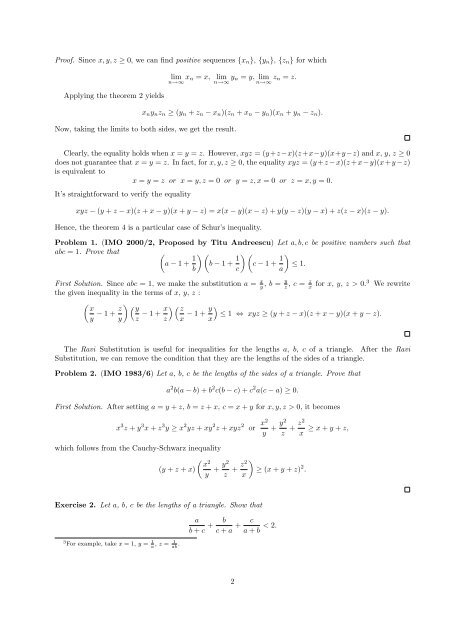Topics in Inequalities - Theorems and Techniques Hojoo ... - Index of
Topics in Inequalities - Theorems and Techniques Hojoo ... - Index of
Topics in Inequalities - Theorems and Techniques Hojoo ... - Index of
You also want an ePaper? Increase the reach of your titles
YUMPU automatically turns print PDFs into web optimized ePapers that Google loves.
Pro<strong>of</strong>. S<strong>in</strong>ce x, y, z ≥ 0, we can f<strong>in</strong>d positive sequences {x n }, {y n }, {z n } for which<br />
Apply<strong>in</strong>g the theorem 2 yields<br />
lim x n = x,<br />
n→∞<br />
lim y n = y, lim z n = z.<br />
n→∞ n→∞<br />
x n y n z n ≥ (y n + z n − x n )(z n + x n − y n )(x n + y n − z n ).<br />
Now, tak<strong>in</strong>g the limits to both sides, we get the result.<br />
Clearly, the equality holds when x = y = z. However, xyz = (y+z −x)(z +x−y)(x+y−z) <strong>and</strong> x, y, z ≥ 0<br />
does not guarantee that x = y = z. In fact, for x, y, z ≥ 0, the equality xyz = (y +z −x)(z +x−y)(x+y −z)<br />
is equivalent to<br />
x = y = z or x = y, z = 0 or y = z, x = 0 or z = x, y = 0.<br />
It’s straightforward to verify the equality<br />
xyz − (y + z − x)(z + x − y)(x + y − z) = x(x − y)(x − z) + y(y − z)(y − x) + z(z − x)(z − y).<br />
Hence, the theorem 4 is a particular case <strong>of</strong> Schur’s <strong>in</strong>equality.<br />
Problem 1. (IMO 2000/2, Proposed by Titu Andreescu) Let a, b, c be positive numbers such that<br />
abc = 1. Prove that (<br />
a − 1 + 1 ) (<br />
b − 1 + 1 ) (<br />
c − 1 + 1 )<br />
≤ 1.<br />
b<br />
c<br />
a<br />
First Solution. S<strong>in</strong>ce abc = 1, we make the substitution a = x y , b = y z , c = z x<br />
for x, y, z > 0.3 We rewrite<br />
the given <strong>in</strong>equality <strong>in</strong> the terms <strong>of</strong> x, y, z :<br />
( x<br />
y − 1 + z ) (y<br />
y z − 1 + x ) ( z<br />
z x x)<br />
− 1 + y ≤ 1 ⇔ xyz ≥ (y + z − x)(z + x − y)(x + y − z).<br />
The Ravi Substitution is useful for <strong>in</strong>equalities for the lengths a, b, c <strong>of</strong> a triangle. After the Ravi<br />
Substitution, we can remove the condition that they are the lengths <strong>of</strong> the sides <strong>of</strong> a triangle.<br />
Problem 2. (IMO 1983/6) Let a, b, c be the lengths <strong>of</strong> the sides <strong>of</strong> a triangle. Prove that<br />
a 2 b(a − b) + b 2 c(b − c) + c 2 a(c − a) ≥ 0.<br />
First Solution. After sett<strong>in</strong>g a = y + z, b = z + x, c = x + y for x, y, z > 0, it becomes<br />
x 3 z + y 3 x + z 3 y ≥ x 2 yz + xy 2 z + xyz 2<br />
or x2<br />
y + y2<br />
z + z2<br />
x ≥ x + y + z,<br />
which follows from the Cauchy-Schwarz <strong>in</strong>equality<br />
( )<br />
x<br />
2<br />
(y + z + x)<br />
y + y2<br />
z + z2<br />
≥ (x + y + z) 2 .<br />
x<br />
Exercise 2. Let a, b, c be the lengths <strong>of</strong> a triangle. Show that<br />
a<br />
b + c +<br />
b<br />
c + a +<br />
c<br />
a + b < 2.<br />
3 For example, take x = 1, y = 1 a , z = 1 ab . 2

















